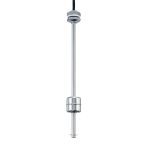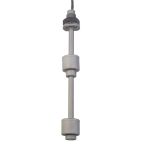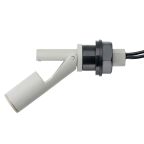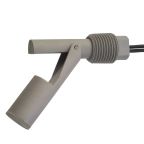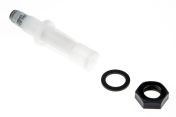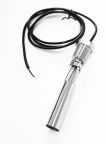Float Switches
Float switches, also referred to as float level switches or water level float sensors, are indispensable devices for monitoring and controlling liquid levels in various applications. These sensors detect fluid levels' rise and fall, triggering a switch to activate or deactivate connected equipment, such as pumps or alarms.
What is a Float Switch?
A float switch is a level sensor used to detect the level of liquid, usually in a tank, container, or well. The flotation part of the device sits on top of the liquid and will switch on the rise and fall of the liquid. Float switches are used for automatic level control in various applications, including:
- Groundwater and wastewater pumps
- Raw water and liquid transfer pumps
- Sewage treatment plants
- High water alarms
How Does a Float Switch Work?
Float switches typically utilise a reed switch and a pivoted magnet to detect liquid level changes. The reed switch is housed within the float, while the magnet is positioned externally. As the fluid level rises or falls, the float moves, causing the magnet to interact with the reed switch, either opening or closing the electrical circuit. This action triggers connected equipment, such as a water pump, to respond accordingly.
Float switches can be configured for normally open (N/O) or normally closed (N/C) operation, and the switching action can be easily reversed by rotating the switch 180°. This versatility makes them adaptable to various control and monitoring scenarios.
What Materials Are Float Switches Made of?
Float switches are constructed from various materials to suit different application requirements and environmental conditions. Here's a closer look at some common materials used in float switches:
- Nylon: This versatile material is known for its durability, chemical resistance, and affordability. Nylon float switches are suitable for oils, diesel, organic chemicals, and other non-aggressive liquids.
- Polypropylene (PP): Offering excellent chemical resistance to acids, alkalis, detergents, and organic chemicals, polypropylene float switches are ideal for harsh liquid applications. They also exhibit good resistance to oils and water.
- Polyphenylene Sulphide (PPS): This high-performance material provides superior chemical resistance, even in high-temperature environments (up to 120°C). PPS float switches are well-suited for demanding applications involving aggressive chemicals and extreme temperatures.
- Stainless Steel: Used extensively in the food and beverage industry, medical applications, and hydraulic systems, stainless steel float switches offer exceptional durability, corrosion resistance, and hygiene. They are compatible with various liquids, including water, chemicals, and hydraulic fluids.
Float Switch Features and Benefits
Float switches offer a range of features and benefits that make them reliable and effective level sensors for various applications:
- Highly Flexible: Float switches can be easily installed and adapted to various tank or container configurations.
- High Mechanical Load Rating: These switches are designed to withstand mechanical stress and pressure, ensuring long-lasting performance in demanding environments.
- Insensitive to Turbulence: Float switches remain unaffected by turbulence or agitation in the liquid, providing accurate level detection even in dynamic conditions.
- Shock and Rupture Proof: Many float switches are designed to be resistant to shocks and impacts, ensuring reliable operation even in harsh industrial settings.
- WRAS Approvals: Some float switches comply with Water Regulations Advisory Scheme (WRAS) standards, making them suitable for potable water applications.
How to Choose the Right Float Switch
Selecting the appropriate float switch involves considering several key factors:
- Storage Tank Size & Depth: Ensure the float switch's cable length and operating range are compatible with the dimensions of your tank or container.
- Control Range: Choose a float switch with a control range that matches your desired level detection points, such as high-level alarm, low-level alarm, or pump control.
- Operating Voltage and Current: Select a float switch with voltage and current ratings compatible with your electrical system and connected equipment.
- Liquid Compatibility: Ensure the float switch's materials are compatible with the liquid being monitored to prevent corrosion or degradation.
- Switching Action: Determine whether you require a normally open (N/O) or normally closed (N/C) switching action, depending on your control requirements.
- Model & Features: Consider additional features like adjustable switching points, built-in delays, or high-temperature resistance, depending on your specific needs.
Industrial Application of Float-Level Switches
Float switches, also known as float-level sensors, play a critical role in various industrial sectors, ensuring precise liquid level management and control.
Petrochemical Industries
In the petrochemical industry, float switches are essential for monitoring and controlling liquid levels in storage tanks, pipelines, and processing vessels. These sensors help prevent overflows, leaks, or equipment damage by accurately detecting high or low levels. Additionally, they enable automated pump operation, optimising liquid transfer and storage processes.
Food and Beverage Industry
The food and beverage industry also relies heavily on float switches to maintain proper liquid levels in tanks and processing equipment, safeguarding product quality and preventing contamination. By providing precise level control, these sensors contribute to efficient production and sanitation processes.
Industrial Automation
In industrial automation, float switches are integrated into sophisticated control systems, enabling real-time monitoring and management of liquid levels. They can trigger alarms or initiate shutdown procedures in case of abnormal levels, ensuring safety and preventing costly damage. Moreover, they optimise pump operation and energy consumption based on real-time level data, contributing to cost savings and environmental sustainability.
Machinery & Equipment
Float switches have also been extensively used in machinery and equipment across various industries. They monitor coolant levels to prevent overheating and damage, control fluid levels in hydraulic systems for smooth operation, and detect water ingress in sensitive equipment to prevent malfunctions, ensuring optimal performance and longevity of critical assets.
Automotive
Even in the automotive sector, float switches play a crucial role. They are used to monitor fuel levels in vehicles and storage tanks, control coolant levels in engines and radiators, and detect leaks or fluid loss in various automotive systems.
Delivery Information
RS offers fast delivery of float switches and other sensors like pressure detectors and photoelectric sensors across Malaysia. For more details on delivery services and fees, please refer to our Delivery page.
Popular Searches
Related links
- Level Sensors
- Float Valves
- RS PRO Float Switch Level Sensor Vertical, Polypropylene Body
- Sensata Cynergy3 Level Switch Float Switch Stainless Steel Body
- Delta-Mobrey Side Mount Aluminium Alloy Float Switch SPST 240V dc Max
- Flowline Switch-Tek Series Vertical PP Float Switch 4.3m Cable 250V ac Max
- Flowline Counter Weight for Use with LV41 Float Level Switch, LV42 Float Level Switch
- Flowline Switch-Tek Series Sump Float Level Switch Float Switch Polypropylene Body
